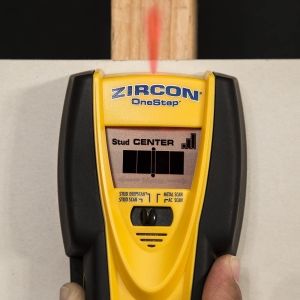Everything You Need to Know About Stud Finders
If you’ve ever tried to hang a picture on a wall and couldn’t find the studs, you know how important it is to have the right tool for the job. This is where the trusty stud finder comes in! It’s true that there are a variety of ways to locate studs without one, but having an electronic device makes it easier, faster, and more accurate. That is what a stud finder does, finds studs.
Now all jokes aside and after you do the same joke as your Dad (move finder over yourself and act like it beeps - Found One!!), let’s take a look at what exactly a stud finder does.

What Do Stud Finders Do?
Stud finders or stud detector, work by detecting changes in density behind walls. They use magnets and/or sensors to detect changes in density within the wall that indicate where nails or screws were used to hold up drywall. This usually means that there’s wood behind it—AKA a stud!
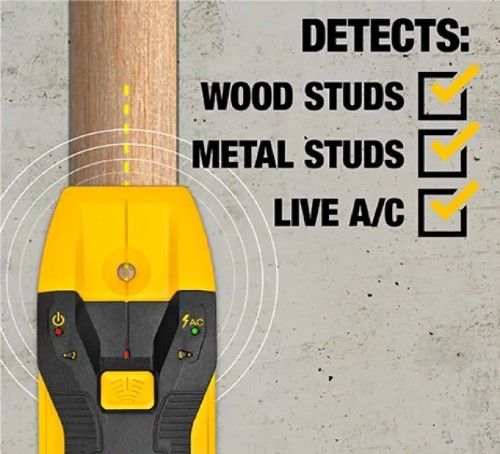
The Best Stud Finders for Any Job
A stud finder will help locate studs which are not visible. It's vital to know where they are so you know you can afix to them rather than simply the drywall if you hang heavy objects, like mirrors or a flat screen TV.
Nonetheless, other stud finders also provide other features, including deep scanning. But it doesn't mean the person does anything he wants. It's hard to account for everything inside walls, despite advancement.
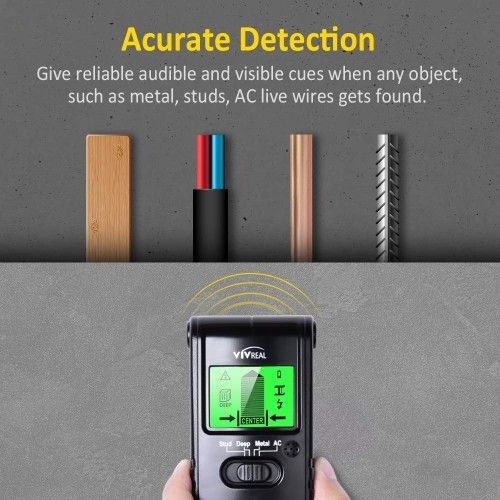
Spending a little more for all the bells and whistles can save you a lot of hassle later.
There are Two Types of Stud Finders: Magnetic and Electronic
The most popular type of stud finder is the magnetic model. They are relatively inexpensive and easy to use, plus they don’t require any special equipment such as batteries or wires—just a simple sweep across the wall with your hand. The downside is that they won’t detect plastic anchors used for hanging shelves or other light fixtures so you might need another tool for those applications.
- Magnetic - Magnetic stud finders work using powerful rare earth magnets to locate screws and nails containing pictures, frames, mirrors, and wall panels. If you slide the finder onto the surface, the magnetic attraction will occur in any area near the nail or screw—and you'll feel it pull.
Are Magnetic Stud Finders Accurate?
Magnetic finds are not merely a way to find an exact stud but instead locate screws (usually screws for drywall). The magnetic finder is lacking in many areas. Usually metal is detected in an interval within the thickness range, usually a little over 2 inches.
The majority of magnet finders are light and have powerful magnetic forces enough to keep through the walls. Magnet stud finders are used at depths between three to five inches which can most commonly locate studs in drywall with a 5-inch or 12-inch wall thickness.
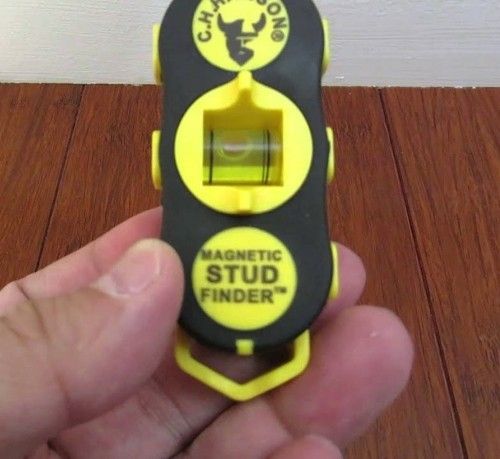
- Electronic - Electronic stud finders use sensors which measure differences in capacitance—the ability of an object to store electricity—to detect metal objects such as metal studs, nails, metal fasteners, and drywall screws beneath the wall surface.
On the other side, stud finders have internal sensors instead of magnets which can help identify studs. The occupants sense an increase in the density in front of the walls. The stud finders available today are pre-calibrated; and some must be calibrated to guarantee precise results. Although electronic stud finders are simple to use, they can easily be mounted on walls or moved vertically in an angle. Upon detection of studs, it emits an audible alarm and produces an image according to the model.
Why Use an Electronic Stud Finder
Electronic models are more expensive but provide more accurate results since they measure capacitance rather than relying on magnets alone. Some also feature additional features such as laser-guided measurement capabilities for even greater accuracy when locating, electrical boxes, copper pipes or plastic pipes, electrical wires or just finding studs behind walls.
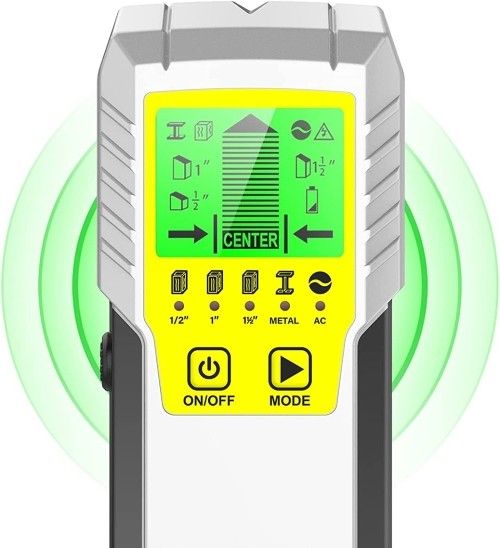
How Stud Finders Work
The Electronic Stud Finder is an electrical - based device which detects the changes in the surface density. Pressing the button creates the magnetic field. It sends feedback from the device for density changes such as moving from the hollow area to the stud area. Many of these devices have an LCD display where the device's readings and light are visible. When an object is detected, the device sounds.
Edge - Edge finders signal if an instrument hits the left edge of a stud.
Center - Stud finder produces multiple magnetic fields that cover stud widths, as well as any other lengths. This makes it easier to locate the center of the stud's location.
How Do You Accurately Read a Stud Finder?
Slow movement, horizontally across walls. The lights are lit indicating the discovery by the finder. You can now move this device around to find the outer corners of the stud; you need the exact diameter for each stud to work with this parameter.
Does a Stud Finder Beep When it Finds a Stud?
Stud Finding Tips - The stud finders can illuminate the edges and beep at any point in the stud. Mark those locations either by putting a pencil mark on a wall or over a piece of tape. Then you can easily locate the stud's center for reference.
Pros and Cons
The Electronic stud finder offers the same advantage as a magnetic stud finder and is the fact that it finds only the studs itself. This helps with a long stretch between metallized fasteners.
A magnetic stud finding system requires a lot of sweeps as well as a need to move up and down.
Electronic gadgets require sweeping horizontally. With edge stud finders it is hard when moving slowly but immediately if you see a signal from the device to stop the move. And you need to repeat that sweep in the opposite direction. Electronic center stud finding devices help identify the true depth of bolts, but only in a small amount.
Regular stud finders don't typically work well where a plaster wall and metal mesh is involved. The signal gets scrambled and rightfully so, since it is all metal below the plaster.
Can You Use Your Phone as Stud Finder?
The advancement of technological tools allows you to use stud finder apps on iPhones, Android and iOS phones. They are using their smartphones magnetometers to metal studs, metal pipes and nails or screws behind the walls. Some of these apps have an extra deep scan mode that enables you to see further into the wall cavity and locate plastic pipe plumbing lines or live electrical wires.
Lets Look at Some of the Most Popular and Highly Rated Stud Finders
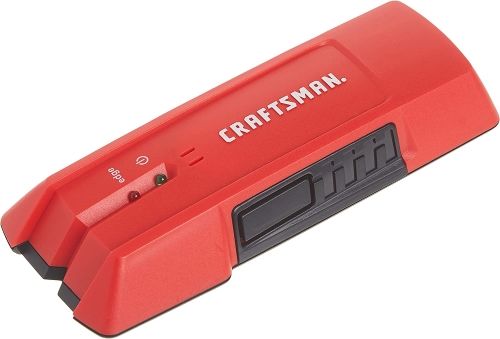
- WORKS ON WALLPAPER & FABRIC: The stud finder has a depth range of 3/4-inch through drywall and works on surfaces covered in wallpaper and fabric
- LOCATE STUD EDGES: The stud finder wall scanner has the edge detection to locate Stud Edges of Both Wood and Metal Stud
- DURABILITY: The wood/metal stud finder has Shock-Resistant & Water-Resistant body for durability and long life
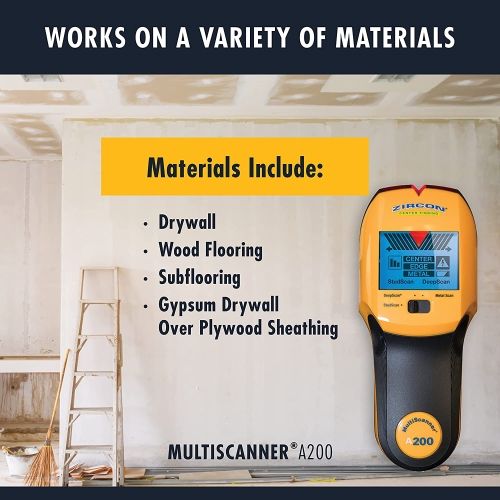
- WireWarning Detection indicates the presence of live, unshielded electrical AC wiring while scanning in all scanning modes
- ACT (Auto Correcting Technology) automatically corrects common user errors, i.e. when scanning begins over a stud, as the Signal Strength Indicator help distinguish shallower targets from deeper ones
- Ergonomically designed grip allows a comfortable hold on the tool for any size hand, at any angle while the Patented SpotLite Pointing System clearly indicates the target location
- One fully charged 9V battery, not included, is required for the stud scanner to run at optimal performance to help you easily find studs and metal while avoiding electrical hazards
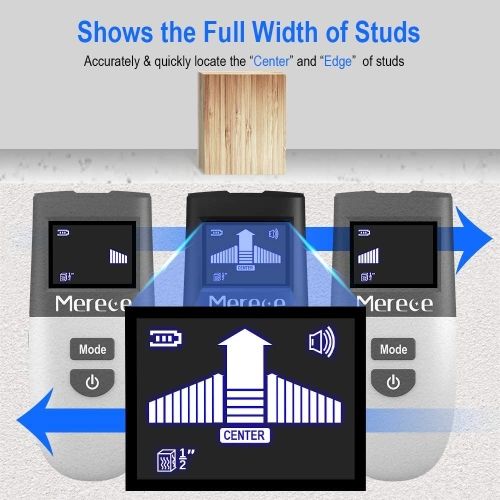
- Advanced with the Latest Technology & More Accurate than Standard Stud Finders- this stud finder wall scanner is launched after testing and upgrades for years. This wall detector adopts the most Advanced Sensor Technology for higher accuracy & efficiency on wood stud metal AC wire detection. Whether you are a professional, homeowner or a DIY enthusiast, you can find great use with this electronic stud scanner
- 5 SCANNING MODES UP TO 60MM DEPTH -Our stud locator has multi-functions and can quickly and easily locate wood metal studs joists beams metal pipe rebar and live AC wire behind walls, floors, and ceilings. Stud Scan Mode scans through one layer of drywall up to 0.5 in.(12mm) and 1 in . (25mm) thick, and Deep Scan Mode for 2 layers of drywall up to 1.5 in. (38 mm) deep. Deep Scan Mode ensures a higher sensitivity when there are extra layers of wallboard.
- Upgraded Design of LCD Screen - Displaying the Desired Stud Material As Well As Its Precise Position - This digital stud scanner features large LCD display together with clear sound to detect the accurate location of stud metal AC wires. The direction and intensity on the LCD display would indicate whether you are closer to the target. This quick detection could save your time and efforts, making your project EASIER.
- Automatic Calibration and Ergonomic Grip for Comfortable Use -A fully calibration before using provides users with maximum reliability and accuracy.And the ergonomic design of this wall stud finder makes it comfortable to hold from any angle.
- Professional Design with Top Quality -Our Product Team has been dedicated to research and develop stud finders for many years, and we have professional technology and mature production process. This stud joist beam finder wall detector can quickly locate metal wood AC wires hidden in the walls, floors and ceilings, helping you find the exact stud while installing TVs, cabinets, garage shelves etc.
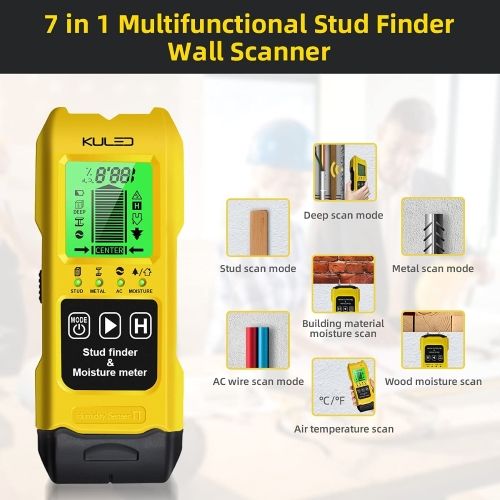
- ▶Accurate and Quickly Location:Kuled stud finder wall scanner 7 in 1 will help you accurate and quickly locate edges and center of stud, metal nails,joists,live AC wire, tubes, steel bars behind all kinds of walls,floors and ceilings.Which will help you avoid hazards while installing TVs, cabinets ect. Whether you are DIY enthusiast or professional, stud detectors will be your good partners.
- ▶7 Scanning Modes:Wall sensor finder locates the center and edges of wood and metal studs up to 3/4 in. (19mm) deep. Deep Stud Scan model up to 1-1/2 in.(38mm) deep. Metal scan detects metal up to 2-2/5 in. (60mm) deep. AC scan detects live AC wires up to 2 in. (51mm) deep. Moisture and temperature measurement model test the moisture content of wood(6%-60%)and Building materials(0.2%-2.9%)for temperature measurements, the display shows the present environment temperatrue from 0-40℃ or 32-104℉.
- ▶Digital LCD Display & Sound Warning :The wood detector in wall has bright LCD display together with the sound warning to detect the accurate location of the objects. When find the target, the LCD display will indicate the direction and the intensity of beeping tells whether you are more close to the target. The beam finder make your work and life more easier.
- ▶Measure Moisture: Pin-Type Wood Moisture Meter Designed with 2 high precision pins, penetrate into the test surface and quickly know the moisture level in your walls.
- ▶What You Will Get:1 x Stud Finder, 1 x 9V Battery, 1 x User Manual; when you use the beam detector, if any further questions, please contact us without hesitation.
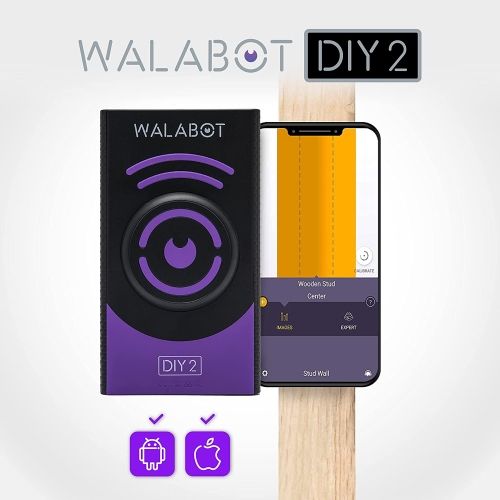
- See it, don’t hear it! Use cutting-edge technology to see into your walls. Don’t just rely on a ‘beep’
- Find the center of wood/metal studs and track pipes and wires up to 4”/10cm inside drywall
- NEW: Works with iOS as well as Android
- NEW: Extended reach: Wi-Fi enabled - work away from your phone
- NEW: Built-in rechargeable battery - won’t drain your phone
- NEW: Enhanced product casing with smooth scanning strips
- Detects the movement of pests inside your walls
- Mobile app provides regular upgrades and feature improvements
- Compatible with iPhone 7 and higher/Android v9.0 and above
.
Why Use a Stud Finder?
A stud finder can be invaluable when it comes to home improvement projects such as mount some decorations or hang picture frames and shelves securely onto walls–without one, your project could end disastrously! Stud finders detect the things you do not want to hit, and what you do. Additionally, if you’re planning any major renovations around your own house such as adding electrical wiring or plumbing pipes behind walls, locating the exact position and entire width of all the wooden frames will be essential for successful completion of your project.
Having a reliable stud finder can make all your home renovation projects smoother and less stressful! Whether you choose an electronic model with advanced features or prefer something simpler like a magnetic one, these tools are invaluable when it comes time to do some DIY work around the house. Not only will they help you locate hidden wall studs easily and accurately, but they'll also save you time (and possibly money) by ensuring that whatever project you're working on is done right the first time around!
A little home improvement advice...don't skimp on the right device. If you have a need for a lot of work and don't know what may be hidden, a more versatile (and expensive) stud finder may be what you need. Be sure to explore all your options. As long as you have a good quality device, using a stud finder should be easy enough even for beginners who have never used one before!
As an Amazon Associate, I may earn from qualifying purchases.

